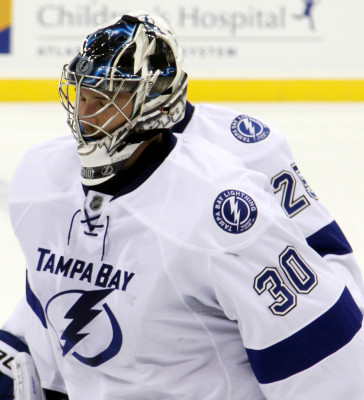
The best part of the NHL is the new 3-on-3 overtime format. The scoring chances are unparalleled and the action will even get a basketball fan out of their seat.
It doesn’t take a scientist to figure out that more scoring attracts the casual fan while keeping the hockey purists obsessed. However, the NHL might be calling up scientists to make its next biggest change — bigger nets.
Longtime NHL commissioner Gary Bettman is aggressively changing how the game is both played and perceived. Along with league officials, team owners and general managers are discussing the implementation of bigger nets and smaller goalie pads. Although still in the preliminary stages, the change could sway the NHL drastically, with similar effects to the 3-on-3 OT format.
The new 3-on-3 format seemed unfathomable just a few years ago. If any changes are made to pads and net size, which appears increasingly realistic, it will most likely be one or the other.
Regardless, the direction of the NHL is glaringly clear: it wants to increase scoring, and in turn, increase attendance and viewership. Up until this season, the NHL has been the slowest of the four major professional sports leagues to implement modern changes to the game. The history of the sport is rich, and the traditionalists are firm in their mindsets, but the 3-on-3 OT is drawing overwhelming support, especially from fans.
The fans are at the center of all of these changes. Bettman and the NHL wants more viewership, and it is committed to the idea that increased scoring is the key to the kingdom, although many hockey purists are threatened by these potential rule changes because it ruins the history and the nature of the sport.
The NHL’s agenda remains wisely calculated. It knows it won’t lose its big fans, and it is determined to lure in the casual fan. Casual fans of the league aren’t big fans mainly because of the lack of scoring.
The size of an NHL goalie currently holds way too much weight, quite literally, in keeping goal totals down. Two of the best goaltenders in the league, Devan Dubnyk and Ben Bishop, take up majority of the net with their couch-pillow sized leg pads.
Hockey is evolving, and as a result, the majority of goals are scored off deflections, screens or lucky bounces. The NHL needs more highlight-reel goals, and by extending the nets by an inch or two all the way around (this is where the science comes in), scoring will increase.
Can you imagine the offensive pace and excitement that will come with Sidney Crosby, Alex Ovechkin, Tyler Seguin and Steven Stamkos having more net to shoot at? It will be unbelievable and will allow for talent to take over like it did back in the day, instead of relying on puck luck and bounces to decide the majority of the outcome.
Ten years ago there was an average of 6.1 goals per game, and so far this year the average is 5.3. That’s a concerning drop over a 10-year stretch. The NHL is starting to catch up with the changing times, and making this change would be another step in the right direction.
Now that team owners and general managers are driving this change, the shift to a higher scoring league is more likely than not. Decisions follow where the money lies, and if team owners continue to assert firm opinions, progressive shifts will be made to draw more fan attendance and thus more money into the owners’ pockets.
History buffs will say you can’t compare generational players such as Crosby and Gretzky. To that, I say that the game changes so much over time that those comparisons are already impossible to make. Furthermore, increasing the net size would actually help that comparison because back in the day goalies and their small pads took up just a fraction of what they do today.
The same people who rejected the 3-on-3 OT are against the idea of bigger nets. However, most opposed to 3-on-3 now love the excitement it brings. Old-school fans will be firm in their ways, but this shouldn’t stop the NHL in its pursuit of a more entertaining product.


I commend you for making a point few people have noticed. That larger nets would make for fairer comparisons between modern and past players, because larger nets would make for a similar amount of net for today’s players as there was for past players. Too many people who talk about bigger nets either leave it at the potential scoring increases or how much against tradition they would be.
Fantastic article with a refreshing angle and some excellent insights! I personally just wanted to chime in with my perspective. I grew up in Texas hating hockey, mostly because as a little kid I was drawn towards the high-scoring, back and forth action of football and basketball. When I moved to the Boston area, it was inevitable that I would be exposed to hockey for what it really is. I fell in love with the Boston Bruins and realized that while the scores might sometimes be lower, most games go back and forth just as much as football or basketball games and that there is an intangible element of hockey that incites even more passion. One goal carries enormous weight and it is often the slightest difference of just a few inches that determines a game that might end 1-0 or 2-1. I absolutely agree with your advocacy of bigger nets or smaller pads. Casual, un-informed fans like me will be drawn to intense contests that go back and forth and perhaps end 6-5 or 7-6. More people will be drawn to the beauty that is hockey.